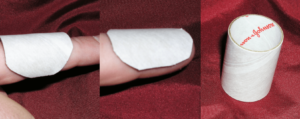Athletic Trainer Tips: Taping and Bracing

Taping and bracing are staple treatments when it comes to many types of sports injuries and are easy ways to stabilize injured joints and sprains while also promoting healing and preventing further damage.
Here are tips on taping and bracing for athletic trainers and how to contact our team at University Orthopaedic Associates if you or one of your players needs treatment for an orthopaedic injury.
Use Athletic Tape As a Makeshift Boutonniere Splint
If you’re on the road and need a Boutonniere splint to straighten and stabilize a mallet finger, use the core of a roll of Johnson and Johnson 1.5-inch Athletic Tape. The curved shape of a tape core can serve as a sturdy, effective splint when trimmed to the appropriate size.
Keep a few empty tape cores on hand, especially when you’re traveling. In events when you don’t have access to a Boutonniere splint, grab a tape core and cut it to length.

Try This Alternative Taping Method For Gamekeeper Injuries
An injury to the first metacarpophalangeal (MP) joint involving the ulnar collateral ligament is often referred to as a “gamekeeper” injury or gamekeeper’s thumb. This injury earned its name due to being frequently sustained by farmers who tended fowl, as the ligament would be damaged when firmly gripping birds by their necks. Today, this injury is commonly seen among skiers due to firmly gripping ski poles.
Traditionally, a sprain to the ulnar collateral ligament (UCL) of the first MP joint is treated using a thumb spica with a check rein, which helps minimize abduction and a valgus force that puts stress on the injured joint. The check rein is secured to the proximal phalanx of the second finger, with a strip of tape placed to cross the web space between the two fingers. This taping method may be effective at limiting stress on the UCL, but some athletes find it too restricting.

An alternative taping method to use for gamekeeper injuries involves using the fourth finger as a point of stability instead of securing the check rein to the second finger. The fourth finger is involved with less mobility and is supported on both sides by other fingers. This taping method still limits the amount of stress placed on the UCL, with the restraint running over the dorsum of the second and third fingers. It is ideal for athletes who need greater functioning of the second finger and who cannot function as well with the first and second fingers being taped together.
To practice this alternative taping method, secure the fingers using half-inch Zonas tape. Then, pinch or roll the check rein to provide it with more strength and to prevent splitting.
Use An Orthoplast Splint For Gamekeeper Injuries
Another alternative treatment for gamekeeper injuries involves using Orthoplast splint material, which may provide greater stability and strength than conventional taping.
Heat the Orthoplast using a moist heat hydrocollator until the material becomes pliable. Then, cut a piece of Orthoplast large enough to cover the thumb from the interphalangeal (IP) joint to the proximal head of the metacarpal. Place the warm Orthoplast material over the thumb and secure it with a flexible wrap to allow the Orthoplast to take the shape of the thumb.
 Next, place the thumb in the desired functional position and run cold water over the splint to help it cool and take proper shape. Remove both the wrap and the Orthoplast, then trim the material to remove any sharp or rough edges. Make the splint to go beyond the IP joint, or trim it to allow for distal segment motion. Proximally, the splint should be trimmed so that the thumb does not impinge on the wrist or scaphoid when abducted.
Next, place the thumb in the desired functional position and run cold water over the splint to help it cool and take proper shape. Remove both the wrap and the Orthoplast, then trim the material to remove any sharp or rough edges. Make the splint to go beyond the IP joint, or trim it to allow for distal segment motion. Proximally, the splint should be trimmed so that the thumb does not impinge on the wrist or scaphoid when abducted.
When using the Orthoplast splint for a gamekeeper injury, the volar side of the thumb does not need to be covered to allow for better functioning. If necessary, the underside of the hardened, shaped material can be covered with Moleskin to provide more comfort.
Secure the splint to the thumb using elastic tape or with straps and velcro.
UOA is committed to the pursuit of excellence in orthopaedic treatment, medical education and training, clinical and bench research and the promotion of community health. We invite all athletic trainers to visit our For Professionals page for more tips like those above.

